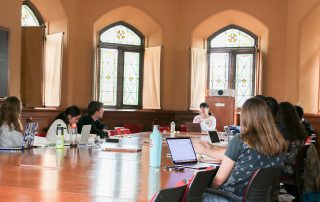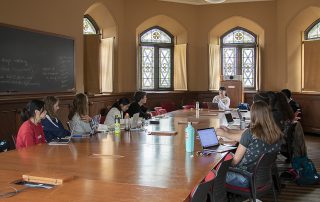Learning Goals
A new gateway course in the Department of English, “Historical Fiction/Fictional History” – developed by Professors Sarah Chihaya and Monica Huerta, and taught in its first iteration by Huerta — takes as its starting point a pressing contemporary question: looking at the categories of “historical fiction” and “history,” how can we read and think critically about the conceptual mechanisms through which we differentiate between facts and fictions, and, in turn, how does this work (invisible and yet tangible) structure the public imagination? Featuring a diverse and interdisciplinary range of texts, including postcolonial Caribbean literature, hybrid texts from African-American studies, and explicitly theoretical texts about “the historical,” the course introduced students to literary study at the college level, challenging their conception of what objects of study and methodological approaches the English major encompasses. Students in the course learned how to read closely, construct and support a textual interpretation, argue clearly in writing in multiple genres, work with archives and archival documents, and engage a rich and varied set of interpretive frameworks, focusing on questions of genre, style, context, and reception.
250th Criteria
“Historical Fiction/Fictional History” addresses an existing gap in the curriculum. It is designed as one of a suite of new courses in the English department that will have broad, appealing themes, and that will introduce first- and second-year students both to the expansive discipline of “English” and the broad range of interests of the faculty. Chihaya and Huerta will teach several iterations of the course, first as a seminar and then as a lecture. As a lecture, the course will emphasize interactivity and metacognition, actively engaging graduate student AIs in the modeling of literary criticism during lecture.
Learning Opportunities
In seminar and written assignments, students had the opportunity to experience the pleasure and the challenge of a close textual encounter. In a particularly compelling conversation about Forest Gump, for example, students joined their work with hybrid and theoretical texts and art works in the Princeton art museum to think about how a film creates not only a sense of “the historical” but also a subject position for the audience through which to understand what to do/not do/feel/not feel/think/not think about history. In the first half of the course, students completed a series of short “exercises in style,” encountering sometimes a fictional, sometimes a historical event in three distinct voices: as journalistic reportage, as historical analysis, and as historical fiction. These assignments asked students to consider the various responsibilities associated with each of these genres, and as such, to consider the intertextual relationships examined in the syllabus. The second half of the course culminated in a final paper that took “Princeton myths” as its broad topic. Students conducted deep archival work at the Mudd Library about their chosen “Princeton myth,” and used that archival work to construct their critical response to it. Students chose from the critical voices they had previously practiced in the course and, through their archival work, were able to reflect on the relationship of fictionality and narrativity in accounts of Princeton’s past. For example, one student who began by researching the myth surrounding the FitzRandolph gate, used her archival work, and the archival silences to write a trenchant critical examination of the changing historical conceptions of the university.
Images


